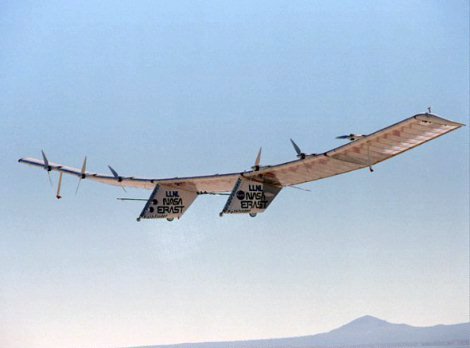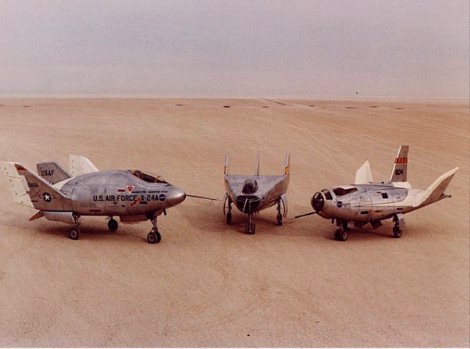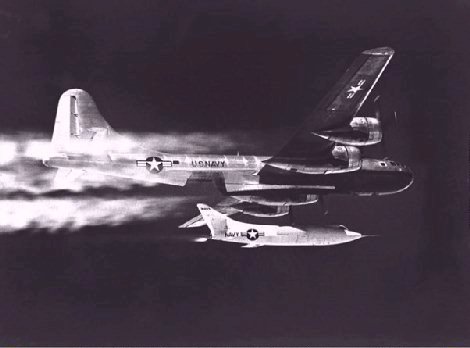Other Crafts
 RECORD FLIGHT:
The pathfinder solar-powered remotely piloted aircraft climbs to a record-setting
altitude of 50,500 feet during a flight Sept. 11, 1995, at NASA's Dryden
Flight Research Center, Edwards, Calif. The flight was part of the NASA
ERAST (Environmental Research Aircraft and Sensor Technology) program in
support of the agency's Mission to Planet Earth effort to study and protect
the environment. The Pathfinder was designed and built by AeroVironment
Inc., Monrovia, Calif. Solar arrays cover nearly all of the upper wing
surface and produce electricity to power the aircraft's six motors. The
aircraft is controlled from a ground station. Target for the current round
of testing, expected to end by October, 1995, is to fly the nearly 100-foot
wide craft to an altitude of about 65,000 feet on a flight that could last
up to 16 hours, with a landing on Rogers Dry Lake at night. The flight
Sept. 12 was nearly 12 hours long and set a new altitude record for solar-powered
aircraft. The old mark was 14,000 feet.
RECORD FLIGHT:
The pathfinder solar-powered remotely piloted aircraft climbs to a record-setting
altitude of 50,500 feet during a flight Sept. 11, 1995, at NASA's Dryden
Flight Research Center, Edwards, Calif. The flight was part of the NASA
ERAST (Environmental Research Aircraft and Sensor Technology) program in
support of the agency's Mission to Planet Earth effort to study and protect
the environment. The Pathfinder was designed and built by AeroVironment
Inc., Monrovia, Calif. Solar arrays cover nearly all of the upper wing
surface and produce electricity to power the aircraft's six motors. The
aircraft is controlled from a ground station. Target for the current round
of testing, expected to end by October, 1995, is to fly the nearly 100-foot
wide craft to an altitude of about 65,000 feet on a flight that could last
up to 16 hours, with a landing on Rogers Dry Lake at night. The flight
Sept. 12 was nearly 12 hours long and set a new altitude record for solar-powered
aircraft. The old mark was 14,000 feet.
 BRIDGING THE GAP:
NASA's unmanned, remotely controlled aircraft, Perseus, flies over Rogers
Dry Lake on it's maiden voyage Dec. 21, 1993, at the Dryden Flight Research
Center, Edwards, Calif. The Perseus, designed and built by Aurora Flight
Sciences Corp., Manassas, Va., was towed into the air by a ground vehicle.
At about 700 ft. the aircraft was released and the engine turned the propeller
to take the plane to it's desired altitude. Perseus is designed to carry
scientific payloads to high altitudes to study atmospheric conditions.
The data collected will bridge a gap between measurements from NASA research
aircraft and space based science experiments.
BRIDGING THE GAP:
NASA's unmanned, remotely controlled aircraft, Perseus, flies over Rogers
Dry Lake on it's maiden voyage Dec. 21, 1993, at the Dryden Flight Research
Center, Edwards, Calif. The Perseus, designed and built by Aurora Flight
Sciences Corp., Manassas, Va., was towed into the air by a ground vehicle.
At about 700 ft. the aircraft was released and the engine turned the propeller
to take the plane to it's desired altitude. Perseus is designed to carry
scientific payloads to high altitudes to study atmospheric conditions.
The data collected will bridge a gap between measurements from NASA research
aircraft and space based science experiments.
 LIFTING
BODIES: The wingless, lifting body aircraft sitting on
Rogers Dry Lakebed at what is now NASA's Dryden Flight Research Center,
Edwards, Calif., from left to right are the X-24A, M2-F3 and the HL-10.
The lifting body aircraft studied the feasibility of maneuvering and landing
an aerodynamic craft designed for reentry from space. These lifting bodies
were air launched by a B-52 mother ship, then flew powered by thier own
rocket engines before making an unpowered approach and landing. They helped
validate the concept that a space shuttle could make accurate landings
without power. The X-24A flew from April 17, 1969, to June 4, 1971. The
M2-F3 flew from June 2, 1970, until Dec. 21, 1971. The HL-10 flew from
Dec. 22, 1966, until July 17, 1970, and logged the highest and fastest
records in the lifting body program.
LIFTING
BODIES: The wingless, lifting body aircraft sitting on
Rogers Dry Lakebed at what is now NASA's Dryden Flight Research Center,
Edwards, Calif., from left to right are the X-24A, M2-F3 and the HL-10.
The lifting body aircraft studied the feasibility of maneuvering and landing
an aerodynamic craft designed for reentry from space. These lifting bodies
were air launched by a B-52 mother ship, then flew powered by thier own
rocket engines before making an unpowered approach and landing. They helped
validate the concept that a space shuttle could make accurate landings
without power. The X-24A flew from April 17, 1969, to June 4, 1971. The
M2-F3 flew from June 2, 1970, until Dec. 21, 1971. The HL-10 flew from
Dec. 22, 1966, until July 17, 1970, and logged the highest and fastest
records in the lifting body program.
 TEST
TEAM: This converted B-29 bomber air launches a D-558-2
"Skyrocket" in the skies above the flight research facility that became
the NASA Dryden Flight Research Center, at Edwards, CA. The D-558-2 program
investigated the flight characteristics of a swept-wing aircraft at high
supersonic speeds, with particular attention given to the problem of "pitch-up",
a phenomenon often encountered by airplanes of this configuration. Douglas
test pilot John Martin was at the controls for the maiden flight on February
4, 1948. National Advisory Committe for Aeronautics (NACA) test pilot Scott
Crossfield became the first man to fly faster than twice the speed of sound
when he piloted the D-558-2 to it's maximum speed of 1,291 mph on November
20, 1953. The Skyrocket set many records for it's day, including a peak
altitude of 83,235 feet set by USMC Lt. Col. Marion Carl.
TEST
TEAM: This converted B-29 bomber air launches a D-558-2
"Skyrocket" in the skies above the flight research facility that became
the NASA Dryden Flight Research Center, at Edwards, CA. The D-558-2 program
investigated the flight characteristics of a swept-wing aircraft at high
supersonic speeds, with particular attention given to the problem of "pitch-up",
a phenomenon often encountered by airplanes of this configuration. Douglas
test pilot John Martin was at the controls for the maiden flight on February
4, 1948. National Advisory Committe for Aeronautics (NACA) test pilot Scott
Crossfield became the first man to fly faster than twice the speed of sound
when he piloted the D-558-2 to it's maximum speed of 1,291 mph on November
20, 1953. The Skyrocket set many records for it's day, including a peak
altitude of 83,235 feet set by USMC Lt. Col. Marion Carl.
 RECORD FLIGHT:
The pathfinder solar-powered remotely piloted aircraft climbs to a record-setting
altitude of 50,500 feet during a flight Sept. 11, 1995, at NASA's Dryden
Flight Research Center, Edwards, Calif. The flight was part of the NASA
ERAST (Environmental Research Aircraft and Sensor Technology) program in
support of the agency's Mission to Planet Earth effort to study and protect
the environment. The Pathfinder was designed and built by AeroVironment
Inc., Monrovia, Calif. Solar arrays cover nearly all of the upper wing
surface and produce electricity to power the aircraft's six motors. The
aircraft is controlled from a ground station. Target for the current round
of testing, expected to end by October, 1995, is to fly the nearly 100-foot
wide craft to an altitude of about 65,000 feet on a flight that could last
up to 16 hours, with a landing on Rogers Dry Lake at night. The flight
Sept. 12 was nearly 12 hours long and set a new altitude record for solar-powered
aircraft. The old mark was 14,000 feet.
RECORD FLIGHT:
The pathfinder solar-powered remotely piloted aircraft climbs to a record-setting
altitude of 50,500 feet during a flight Sept. 11, 1995, at NASA's Dryden
Flight Research Center, Edwards, Calif. The flight was part of the NASA
ERAST (Environmental Research Aircraft and Sensor Technology) program in
support of the agency's Mission to Planet Earth effort to study and protect
the environment. The Pathfinder was designed and built by AeroVironment
Inc., Monrovia, Calif. Solar arrays cover nearly all of the upper wing
surface and produce electricity to power the aircraft's six motors. The
aircraft is controlled from a ground station. Target for the current round
of testing, expected to end by October, 1995, is to fly the nearly 100-foot
wide craft to an altitude of about 65,000 feet on a flight that could last
up to 16 hours, with a landing on Rogers Dry Lake at night. The flight
Sept. 12 was nearly 12 hours long and set a new altitude record for solar-powered
aircraft. The old mark was 14,000 feet.


